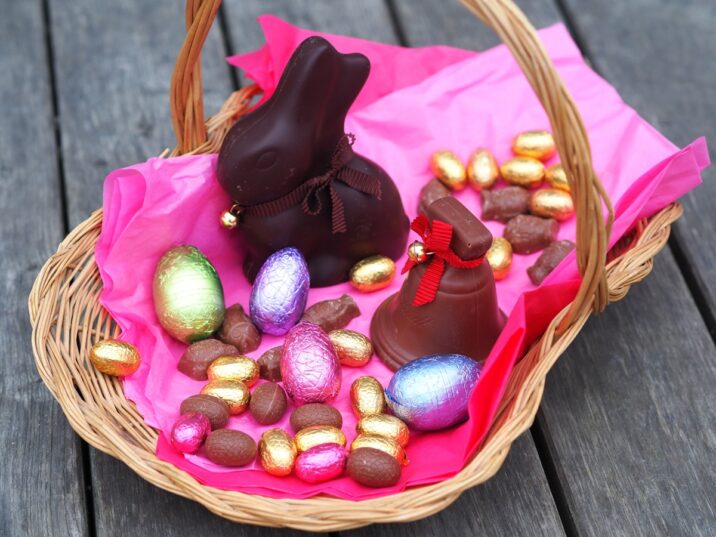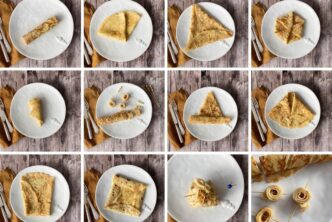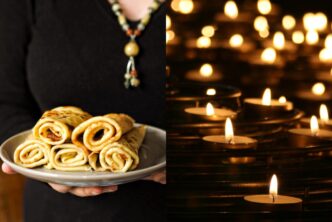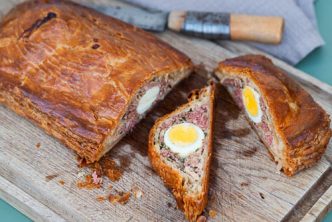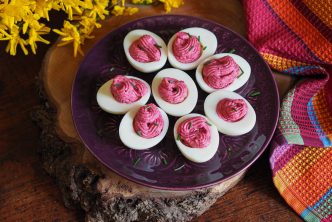At Easter in France, chocolates are decorating every store’s windows. But do you know why we eat chocolate eggs at Easter? Where does this tradition of decorating, hiding eggs but also rabbits, chickens, fish, fried foods come from…
Why do we organize a big egg hunt to the delight of children (and chocolate maker)
In France Easter, or Pâques as we call it in French, is a real fest for most children can’t wait to start the chasse aux œufs (eggs hunt, talking of eggs but any chocolate delight is accepted!).
Kids eat chocolate at Easter in France… but adults too! And as the French love to indulge themselves, most pastry chefs of chocolatiers, from the small factories to renown chocolatiers, create the most amazing shapes or decoration.
As usual, as I have done for other gastronomic traditions, I did a little digging to see where these customs come from.
And it turns out that it is an ancestral and multicultural celebration, resulting from pagan customs that became a Christian celebration symbolizing the resurrection of Jesus Christ at the end of Lent.
Origin
As is often the case, this celebration has pagan roots dating back to the antiquity period. The egg, a sign of promise of life, is therefore associated with the return of the sun in spring after long months of winter.
The first customs with eggs date back 5000 years, among the Persians and Egyptians who offered dyed chicken eggs to bring good luck and celebrate the emergence of spring, the return of new life.
The decorations present on the eggs symbolize different wishes (sun for wealth, deer for health, rooster or hen for happiness, flower for love).
Later the Romans would offer or break eggs which had been previously colored by root decoctions to purify the atmosphere on spring days, they would also be offered to the goddess Ceres of agriculture, I have seen both explanations.
In Gallic antiquity, the Druids dyed eggs red in honor of the sun.
Easter as we know it today is a Christian celebration celebrating the end of Lent and therefore the resurrection of Christ 3 days after his death.
It was at the Council of Nicaea, in 325 AD, that it was decided by the church that the Easter celebrations would be on the first Sunday following the spring equinox.
Once again Christian customs take up the calendar of pagan traditions. The Christian celebrations of Easter begin 40 days before Easter with Lent and extend from Holy Thursday, in memory of the Holy Last Supper of Jesus with his apostles, to Good Friday, the death of Jesus, and until his resurrection 3 days later.
It was forbidden to eat eggs during the 40 days of Lent. As the eggs accumulated, it was customary to decorate them and offer them on Easter Day, at the end of deprivation.
The peasants had the habit of dating the eggs by coloring them, from the darkest for those dating from the beginning of Lent and therefore too old and inedible, to the lightest, those which were cooked.
Therefore the cuisine at the end of these celebrations was rich in eggs: omelettes, cakes…
Symbolism behind the chocolate shapes
Today we tend to celebrate using chocolate eggs rather than real eggs. This idea appeared in the 18th century, with the development of chocolate in the West.
Today Easter brings joy to chocolate makers who compete in creativity, bigger and more intricate shapes and designs appear every easter. There are more than 15,000 volumes of chocolate that the French eat at Easter each year.
Have you ever wondered what the symbolism behind the different shapes we find in easter mean?
Eggs
The main chocolate shape seen, sold and bought at easter are eggs. As touched on previously, that is because before chocolate was exported in large quantities around the world, easter was celebrate by eating real eggs that been saved up during the Lent period.
Eggs have had a strong symbolism throughout time and cultures. The egg, in a pure form, represents renewal, the mystery of life capable of being reborn, again and again (besides, who came first, the chicken or the egg?). For these reasons, it is used to celebrate spring.
It began with the Incas (with the sun god who sent 3 eggs made of gold, silver and copper), then in India, in China, in Egypt, in Africa… For the Jews, the The egg symbolizes both life and death as they celebrate Passover (which gave its name to Easter from what I have read, I still need to delve deeper into Jewish traditions). I’ll stop there, that’s not the point here.
Bells
Chocolate bells can also be found during Easter, this is because at the origin of the Easter celebrations, the bells did not ring between Maundy Thursday and only re-ringed on Easter Day as a sign of joy at the return of Christ.
The legend said that the bells went to Rome to the Vatican to be blessed by the Pope and returned with eggs. In some families the bell is rung to let the children know the easter hunt is ready.
Rabbit
So the bells bring the eggs but it is said that it is the rabbits who hide them in the gardens. Rabbits are another very recurring chocolate found during Easter.
The tradition of rabbits and hares is of Anglo-Saxon origin (later spread in the United States, the Easter bunny) and Germanic.
The German rabbit represents a goddess. I’m not very sure here because I’ve read several things. The goddess Eostre (Easter in English) who was celebrated during the spring equinox (the spring equinox is the day when the sun rises exactly in the East) or the goddess of fertility. The rabbit therefore represents abundance, renewal, and the proliferation of life.
A legend says that a woman without money, to give a gift to her children, decorated eggs and placed them in the garden. The next day, the children saw a rabbit in the garden and concluded that it was the rabbits who were hiding the Easter eggs.
I will continue digging and update this article if I find anything interesting. As you may know I enjoy discovering the stories behind traditional dishes or certain celebrations we continue to enjoy toady throughout the year. You can find all my little investigations in French gastronomy section of my blog, where you can find out why we celebrate Candlemas, Epiphany or even why we eat yule cakes on Christmas.

